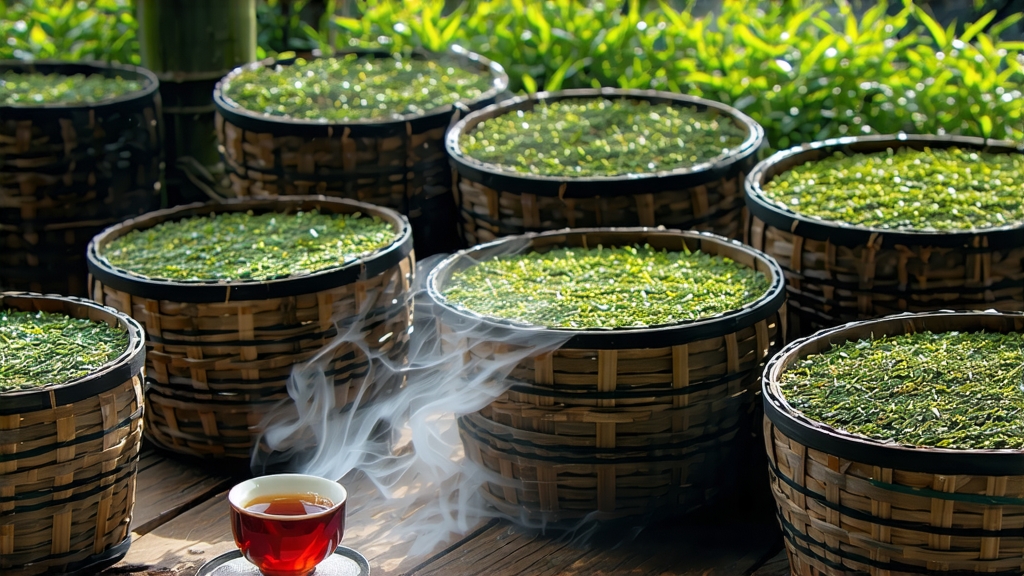
Long before English tea clippers raced across the oceans and before Duchess Anna poured the first cup that launched afternoon tea, there was Lapsang Souchong. Nestled in the granite folds of the Wuyi Mountains of northern Fujian, this rugged corner of southern China gave the world its very first fully oxidised leaf. Local legend claims the style was born in 1646, when a passing Qing army commandeered a tea village near Tongmu Pass. To dry the plucked leaves before the soldiers confiscated them, farmers spread them over pine fires; the smoke impregnated the leaf, creating a flavour so arresting that Dutch traders in Xiamen paid double the usual price. Whether myth or marketing, the story underscores a truth: Lapsang Souchong is the progenitor of every black tea on Earth, the original “red tea” (hong cha) that would later seed Assam, Ceylon and Kenya.
The name itself is a linguistic fossil. “Souchong” refers to the fourth and fifth leaves on a tea bush—larger, tougher foliage once deemed too coarse for the green-tea tribute demanded by the Ming court. “Lapsang” is an anglicised corruption of “Lei Xun,” the pass where the smoke first met the leaf. Today the European Union recognises Tongmu Village as a Protected Designation of Origin; only leaf grown within the 565 km² core of the Wuyi National Nature Reserve may legally bear the name Lapsang Souchong.
Within that microclimate, three distinct styles have evolved. Traditional Pine-Smoked Lapsang is crafted exactly as it was four centuries ago: leaves wither over open pinewood fires, are rolled by hand on bamboo trays, oxidised in cloth-lined baskets, then re-dried above resin-rich long-yan pine until the smoke fuses with the cell walls. The result is a glossy, charcoal-black strip that smells of campfire, bacon and wet bark. A second, newer expression—Wuyi Bohea—omits the final smoking. It relies instead on the natural fruitiness of the Wuyi cultivar and a longer oxidation to produce a maltier, wine-red liquor reminiscent of cacao nibs and dried longan. The third, most delicate version is called Wild Lapsang: leaves picked from unpruned tea trees above 1 200 m, carried out by foot because no road reaches the groves. Wild Lapsang is only lightly smoked, yielding a liqueur the colour of antique copper and an aroma that oscillates between pine resin, wild honey and mountain orchid.
Crafting any of them begins at dawn, when the air is cool enough to keep the leaf from “burning red” prematurely. Pickers take only the standard “two larger leaves and a bud” set, but unlike green-tea standards they wait until the serrated edges turn slightly yellow, a sign that polyphenol oxidase is already waking. Back in the village, the leaves are spread on hemp cloth laid over slatted bamboo racks suspended two metres above a pine pit. The fire below is never allowed to flame; smouldering logs release a cool, aromatic smoke that circulates for eight to ten hours while the leaf loses 65 % of its moisture. This unique wither-smoke phase fixes the signature phenols—guaiacol and syringol—that later translate into smoky sweetness. Once the leaf is pliable, workers roll it in small batches inside linen sacks, twisting just enough to rupture cell walls without breaking the strip. Oxidation follows in pine-wood cupboards lined with wet cloth; temperature is maintained at 26 °C and humidity at 85 % for three hours, during which the leaf turns from olive to mahogany. The final drying, called “lao huo” (old fire), lasts less than ninety seconds over a pine charcoal brazier at 90 °C, locking in the fragrance and reducing moisture to 4 %.
To brew Lapsang Souchong well is to balance its assertive personality without drowning its subtlety. Gongfu style is ideal: 5 g of leaf in a 120 ml porcelain gaiwan, water just off the boil at 95 °C. The first infusion, a lightning 5-second rinse, is discarded to awaken the leaf and rinse away surface smoke. Subsequent steeps lengthen in five-second increments